Removing
OHC engine
Pistons and connecting rods can be removed without removing the engine, for example, to replace any piston or connecting rod bearing. In this case, it is necessary to remove the cylinder head and oil pan as described in the relevant section.
Loosen the bolts and remove the oil pump suction pipe and oil damping sheet. If more extensive repairs are required, the engine must be removed.
Pistons and connecting rods are pressed upwards with a hammer handle. After that, the covers and shells of the connecting rod bearings can be removed. Before carrying out the above work, it is necessary to familiarize yourself with the following instructions regarding markings, installation directions and other features:

1. Each connecting rod and piston group must be marked with the corresponding cylinder. It is best applied with paint on the piston crown (illustrations). Here it is also necessary to put an arrow pointing to the front of the engine. The piston crowns are marked. However, due to soot, they may not be visible. In addition, they can be damaged during the removal of carbon deposits.

2. When removing the piston with connecting rod, pay attention to the installation direction of the connecting rod bearing cap. Before removing the cover, it is necessary to mark the connecting rod and cover with the cylinder number on one side (illustrations). This is best done with a punch (cylinder #1 with one center punch, cylinder #2 with two punches, etc.). The connecting rod and connecting rod bearing cap must be assembled in such a way that the protrusions on the connecting rods, shown by the arrows in the illustration, look towards the clutch, if the arrow or mark on the piston crown points towards the distribution mechanism drive.
3. Connecting rod bearing shells are marked according to the connecting rod and cap. The marking is applied with paint on the reverse sides of the upper and lower bearing shells.
4. If the piston was disconnected from the connecting rod, then it is necessary to replace all elements of the piston assembly, piston pin and connecting rod. The pistons are removed as follows. This means that the engine is removed and the cylinder head, oil pan and oil pump exhaust pipe are removed:
5. Remove the bearing caps and take out the liners. Push the piston groups up as described earlier. If necessary, remove carbon deposits from the top of the cylinders with a scraper.
6. Check the piston group as described later on this page. If wear or any damage is found, the entire group is replaced.

7a. If it is necessary to replace only the piston rings, they are removed with special pliers in order through the piston crown. The pliers are mounted on the piston ring as shown in illustration. 7a and the ring expands until it exits the groove. If the rings are to be reused, they must be marked.

7b. If there are no special pliers for removing rings, then steel strips can be installed under the rings, as shown in the illustration. 7b. One strip must be installed at the end of the ring to prevent damage to the piston. The assembly of pistons and connecting rods for different types of engines is described separately.
Engine 2.0 l OHC since the middle of 1995 of release
The crank mechanism of this engine is completely taken from the previous engine. Therefore, the above description applies to this engine.
Engine 2.4 l OHC
Work is carried out in the same way as the scheme described above, including marking the bottom of pistons, connecting rods, etc. The arrow or mark on the piston crown must face forward. The lug on the connecting rod must face backwards. The piston pin is held by retaining rings.
DOHC engine
The instructions given for the OHC engine are valid for the DOHC engine as far as removal is concerned. There are differences when disassembling the connecting rod and piston group, since in this case the parts of the group can be replaced independently of each other. You should also pay attention to the design of the engine oil pan until the end of 1997 and beyond. Details are described in the relevant section.
1. Mark each connecting rod and piston group as assembled. There is a machined lug in the middle of the connecting rod cap. The tip of this tide should point towards the flywheel.
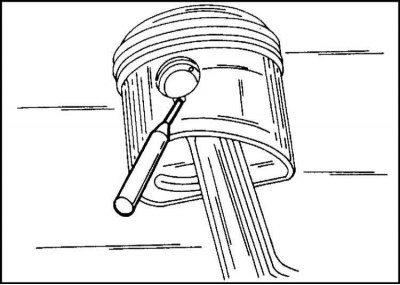
2. Press out the piston pin after removing the circlips. The selection in the area of the hole for the finger allows you to use a mandrel to remove the circlips, as shown in illustration. The pin is pressed out using an appropriate mandrel. Be careful not to damage the piston. If necessary, the piston can be slightly heated.
3. Piston rings are removed as described above (illustrations 7a). Store the rings in the order in which they were installed on the piston, if they are to be installed again in the future. Before installing the piston ring, they must be checked. At the same time, the height gaps between the piston rings and grooves and the gaps in the lock are checked. If a new piston is installed, new piston rings must also be installed.
Cylinder diameter measurement
These instructions apply to all types of engines.

The diameter of the cylinders is measured with a micrometric caliper in three zones and in two directions (illustrations). The top and bottom chords are respectively 10 mm below the top and bottom edges of the cylinder. A total of 6 measurements are taken for each cylinder. The values obtained should be recorded and compared with the values given in Specifications. In this case, it is necessary to keep in mind the difference in values for different types of engines.
If the values of the diameters of one of the cylinders are outside the specified limits, then it is necessary to bore all the cylinders of the engine. A deviation of 0.04 mm from the specified diameter value is allowed. IN Specifications diameters of repair cylinders are given.
The cylinder bore diameter is defined as the sum of the piston diameter, measured in a section at right angles to the bottom, and the gap in the piston-cylinder interface. In addition, it is necessary to take into account the allowance of 0.02 mm left for honing. The operation in question must, of course, be carried out in a specialized auto repair shop. Its description is provided here for information only.
To check the clearance in the piston-cylinder interface, their diameters are measured, as described above. The difference in diameter is the gap. If it goes beyond the permissible limits, the cylinders must be ground.
Checking pistons and connecting rods
Check all details carefully. In the presence of scoring, deep scratches or signs of wear, the parts are replaced. The parts in question are subject to the following checks:
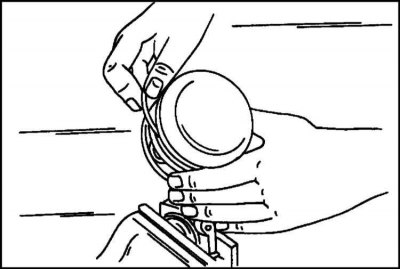
1. Measure the height gaps between the piston rings and grooves with a feeler gauge by inserting the rings into the corresponding grooves (illustrations). If the specified clearance value is exceeded, the piston ring or piston is worn.
2. In order, insert all the rings into the cylinder block. With the piston turned upside down, move the rings down 15 mm.
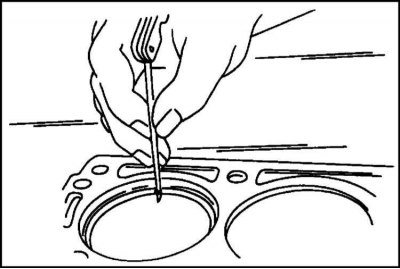
3. Measure the ring gap with a feeler gauge (illustrations). The ring is located under the lower edge of the cylinders. The measurement can also be taken from the underside of the cylinder. Compare the obtained values with the data in Specifications. The gaps must not exceed the wear limit.
4. With too little clearance (e.g. on new rings where the clearance must also be measured) the ends of the rings can be sawn down with a file. To do this, a file with a fine notch is clamped in a vice, and the rings are sawn in this position. If the gap is too large, the ring must be replaced.
5. Check the piston pin and its bore in the connecting rod for wear and tear (only if the details will be re-applied). If there is a defect in one of the parts, both are replaced as a set.
6. Check the connecting rods in a special tool for misalignment and misalignment of the axes of the connecting rod heads.
7. Connecting rod bolts are always replaced. Secondarily, they do not apply.
Measuring clearance in connecting rod bearings
This operation is described below in the subsection "Checking the parts of the crankshaft".
Assembling the connecting rod and piston group
Engine 2.0 l OHC
When replacing pistons, they are all set to the same size.
1. Before assembling the connecting rod and piston group, the connecting rod head must be heated to a temperature of 280°C, for which you can use, for example, a stove with a thermostat. It is also desirable to have a color rod for heating control.
Due to these difficulties, it is recommended that the assembly of the connecting rod and piston group be carried out by a car repair shop. If the engine is removed from the car, it is also recommended to take the cylinder block to the body shop in order to correctly select the pistons.
Attention! If the piston pin could not be pressed in as described above the first time, or the installation direction of the piston or connecting rod is confused, the connecting rod and piston group must be replaced. Of course, such a situation should be excluded.
It must also be kept in mind that all connecting rods must be replaced as a set, as they are only matched by weight as a set.
Engine 2.4 l OHC
In the engine under consideration, the piston pin is fixed with retaining rings. Therefore, the assembly in this case is carried out in the same way as for the DOHC engine (see below).
DOHC engine
The piston with the connecting rod of this engine is easily assembled after the connecting rod head is heated. The correct orientation of the piston and connecting rod must be observed. The lugs on the connecting rod and bearing cap must be on the same side as the boss area for the piston pin.
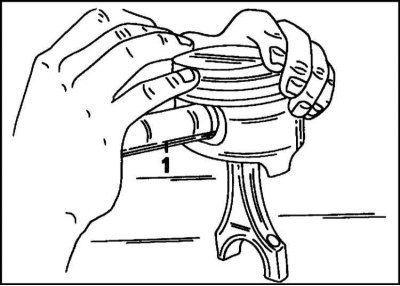
1. Lubricate the piston pin generously (1), insert the connecting rod into the piston and insert a pin through the piston and connecting rod head. While holding the piston as shown in the illustration, push the pin in until it rests on the circlip on the opposite side. After that, install the second retaining ring. Check the reliability of the location of the rings in the grooves.
For all engines
1. Using special pliers, install all the piston rings in order in the grooves (see illus. 7a). Compression rings can be mixed up. Therefore, it is necessary to pay attention to their labeling. The marking must be visible from the side of the piston crown.
Installing the connecting rod and piston group
OHC engine
1. Lubricate the cylinder walls liberally with oil.
2. Lay out the connecting rod and piston group in accordance with the markings and the instructions given above.
Engine 2.0 l
1. The arrows on the bottom of the pistons must point towards the front of the engine.
Engine 2.4 l
1. With this engine, the arrow or mark on the piston crown must point forward. The lug on the piston should point back.
The engine has 2.0 l
1. The locks of the compression rings must be at an angle of 180°to each other. The oil scraper ring locks must be shifted 25-50 mm to the right and left relative to the lock of the middle compression ring. The locks are displaced by turning the rings. The second ring is labeled "TOP", which after installing the ring should be visible from above.
The engine has 2.4 l
1. The top and bottom rings are marked "TOP". Both markings must face up. The oil scraper lock must be rotated 180°relative to the compression ring.

2. Grasp the piston with a steel band as shown in the illustration and press the rings into the piston. Check the tightness of the ring and the direction of installation of the piston.
3. Turn the crankshaft so that two of the connecting rod journals are at the bottom.
4. Insert the connecting rod from above into the cylinder. To do this, lay the engine on its side so that the connecting rod can be directed to the crankshaft journal, and the cylinder walls and connecting rod bearing are not damaged. The connecting rod bearing shell must be in the connecting rod and be inserted with a lug into the selection on the connecting rod.
5. Enter the piston into the cylinder so that the piston rings smoothly enter, and the heel of the connecting rod sits on the crankshaft journal. Check immediately that the arrow on the piston crown is pointing in the direction of the distributor mechanism.

6. Insert the second liner into the bearing cover, generously lubricating it. Place the cap on the earbud and tap it lightly. Please note that the markings (illustrations) were turned to one side.
7. Install and tighten new connecting rod bolts.
2.0L OHC engine
1. Tighten the connecting rod bolts alternately to 35 Nm. From this position, tighten the bolts by 45°and then again by 45°.
The engine has 2.4 l
1. Tighten the connecting rod bolts on the left and right to 45 Nm.
All engines
1. After installing the connecting rod, rotate the crankshaft several times and identify resistance, if any.
2. Reinstall the other two connecting rod and piston groups by rotating the crankshaft accordingly.

3. Once again check up marking of all rods according to illustr. ledges (1) on the connecting rod bearing caps must face the flywheel. Also check the installation direction of the pistons (see illus. 1).
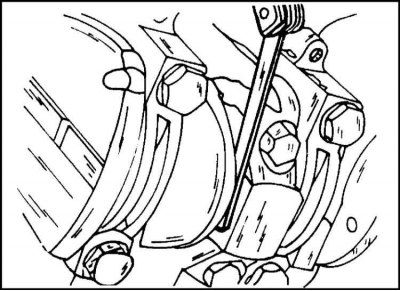
4. Measure the gap between the side surfaces of the connecting rod and the cheeks of the crankshaft with a feeler gauge, as shown in illustration. The axial clearance should not exceed 0.20-0.40 mm.
5. Coat the mating surfaces of the oil pump and crankshaft rear bearing cap with sealant. Install a new oil flinger and tighten the mounting bolts.
6. Install the oil pickup pipe to the cylinder block. First tighten the bolts securing the pipe to the oil pump to 8 Nm (lubricate the thread "Loctite"), then secure the holder to the cylinder block with a torque of 6 Nm.
7. Other assembly work is carried out in the reverse order of disassembly, i.e. oil pan, cylinder heads, etc. are installed.
DOHC engine
The installation of connecting rod and piston groups on this engine is carried out in the same way as on the OHC 2.0 liter engine. The location of the piston rings is also similar here. Follow the instructions for the 2.0L engine. This refers to the tightening torque of the connecting rod bolts.
The installation of the oil pan will be carried out in accordance with the instructions given in the relevant section, because this operation differs depending on the year of manufacture of the engine. (before and after 1997).

Visitor comments